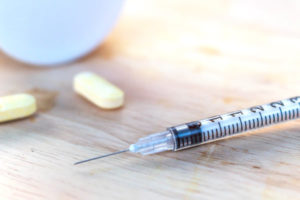Fentanyl Addiction
The grip the opioid crisis has on the United States comes as no surprise, and it seems that American culture is being reshaped by the sheer volume of deaths we see as a result. While it will never be accepted in our society or our culture, we have seen a shift in attitude about the crisis.
Drugs like fentanyl were only meant to be used under the strict supervision of a medical professional. It was designed to treat patients who had exhausted all avenues for medication to treat their chronic pain, but over the years it has been showing and tainting drugs from Norcos to heroin, which is contributing to the crisis affecting our nation.
Every day, more than 115 people in the United States die after overdosing on opioids. Opioid use began in the late 1990s as pharmaceutical companies began reassuring the medical community that their patients would not become addicted to prescription opioid pain relievers. These words carried significant weight as healthcare providers opened the floodgates of prescribing. It was then the crisis began. Eventually, with so many opioids flowing freely, the misuse of the medications became clear and how addictive they were was obvious.
The problem with fentanyl is how easily the precursor is flowing from China into countries like Mexico who synthesize it in clandestine labs. The United States has recently released a statement stating that “U.S. officials have proposed strategies for Beijing to systematically control all fentanyl substances, but the Chinese government has not approved the changes.
To curb this epidemic is going to require help from all sides, and when the Chinese government is not offering its support to reduce the output of a dangerous substance, it poses real dangers. It indicates they do not care about our crisis.
The opioid problem shows no early signs of slowing down, and the emergence of deadly drugs like fentanyl is only going to exacerbate an already raging fire. In October 2017, President Donald Trump officially declared opioid abuse as a public health emergency. This crisis is one of the most pressing the country has ever seen, and it is estimated to claim a life every 19 minutes, according to the U.S. Surgeon General, and costs associated with opioids reached a staggering $78.5 billion in 2016. It is hard to ignore the mark fentanyl has been making in the United States, and if you suspect someone is suffering from an addiction to it, you must be familiar with the warning signs.
What Is Fentanyl?

Fentanyl is a synthetic opioid that was originally used as a medication under the supervision of medical professionals but has since exploded to become a sought out recreational drug by experienced drug users.
As a medication, it’s used as a fast-active painkiller that is often used in epidurals during labor. Labor is unpredictable by nature, and fentanyl can work in as little as 10 minutes, making it the ideal medication for this beautiful act of life.
In comparison to other opioids, fentanyl is unique because it has a high transdermal bioavailability meaning it can be absorbed into the bloodstream through the skin.
Fentanyl works in the central nervous system (CNS) similar to other opioids, but the difference is the sheer strength. Fentanyl is 50 times stronger than heroin and 100 times stronger than morphine. Our body makes its own opioids called endorphins which can dampen painful stimuli to the brain.
Exogenous opioids like fentanyl are much stronger than these endogenous endorphins and can “hijack” our body’s ability to sense pleasure, reward, and even pain.
What Are the Signs of Fentanyl Addiction?
Fentanyl can bring effects consistent with the use of other opioids. Opioid users often seek out drugs like heroin of prescription drugs, but common excuses of how people get hooked on fentanyl is that they had no other choice. There are many stories of those people saying they’d pay more for heroin, but all they could get is fentanyl. Only 25 percent of those interviewed sought fentanyl or fentanyl-laced heroin over other opioids.
Overdose is the biggest threat faced with fentanyl use because if you encounter the drug unwillingly, only a small amount can cause death. As mentioned above, it is 50 times stronger than heroin, and someone who takes a dose they’ve grown accustomed to of heroin will find themselves death immediately from overdose if fentanyl is present. Those who do take the drug can find it euphoric, which causes them to continually use and fall into the trap of addiction.

There are warning signs that come with addiction. This is especially true if someone has graduated to fentanyl use. It starts with a tolerance, which is when the body becomes used to an opioid and starts to counteract it to balance out brain chemistry. As the tolerance continues to grow, you could begin to develop a dependence on the drug. If you stop or cut back at this point, you could experience cravings and intense withdrawal symptoms.
Finally, an addiction could be reached. This is defined as compulsive drug use despite the consequences. If you have health problems because of fentanyl use but continue to ingest the drug, this could indicate addiction.
If you are worried that a friend or family member might be struggling with fentanyl addiction, some behavioral signs to look out for include:
- Trying and failing to stop using
- Reckless behavior
- Obsessive thoughts or actions
- Lying about drug use
- Failure to see the problem with addictive behavior
- Hiding drugs around the house
- Isolation
- Loss of interest in normal activities
- Strange sleep patterns
- Irritability
How Dangerous Is Fentanyl?
Fentanyl is one of the most dangerous drugs on the planet. A small amount of fentanyl can cause a person to fatally overdose, and it can easily be mixed into heroin or other drugs without the user ever knowing. As little as 2 milligrams is enough fentanyl to be lethal, and to put that into perspective, it is the same weight as a single snowflake.
How Is Fentanyl Addiction Treated?
Fentanyl 101
While withdrawal from fentanyl is not inherently dangerous such as what you’d experience with barbiturates or benzodiazepines, they are extremely uncomfortable and require the most intensive level of care to ensure the client does not give up in the middle of the process. The first level of care in addiction treatment is medical detoxification. This will allow the client to have 24-hour supervision to ensure they’re responding properly to treatment. This also will be an ideal situation if there are other pressing medical issues that require intensive supervision of a medical staff.
Upon completion of detox, the medical staff and addiction specialists will help you find the next level of care that is best suited for your needs. Addiction is an extremely complex disease that requires customized care to ensure you meet each individual need. A therapist will assist you in creating a plan that specifically addresses those needs.
Addiction treatment will involve behavioral therapies, group therapy, and family therapy that all offer answers about why you began using in the first place. This will help you get to the root of your addiction and encourage you to address the triggers that may arise when you leave treatment. You will also create relapse prevention plans that will equip you for life long after you leave treatment.
Fentanyl Abuse Statistics
- Opioid overdose deaths increased by 100% during the past decade.
- Among the 72,000 overdose deaths in 2017, the sharpest increase involved fentanyl and its analogs.
- Synthetic opioids, like fentanyl, accounted for about 29,406 deaths in 2017.


